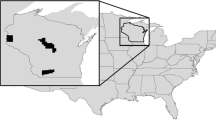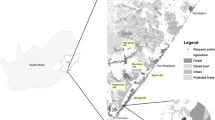Abstract
Biodiversity persistence in non-woody tropical farmlands is poorly explored, and multi-species assessments with robust landscape-scale designs are sparse. Modeled species occupancy in agricultural mosaics is affected by multiple factors including survey methods (convenience-based versus systematic), landscape-scale agriculture-related variables, and extent of remnant habitat. Changes in seasonal crops can additionally alter landscape and habitat conditions thereby influencing species occupancy. We investigated how these factors affect modeled occupancy of 56 resident bird species using a landscape-scale multi-season occupancy framework across 24 intensively cultivated and human-dominated districts in Uttar Pradesh state, north India. Convenience-based roadside observations provided considerable differences in occupancy estimates and associations with remnant habitat and intensity of cultivation relative to systematic transect counts, and appeared to bias results to roadside conditions. Modeled occupancy of only open-area species improved with increasing intensity of cultivation, while remnant habitat improved modeled occupancy of scrubland, wetland and woodland species. Strong seasonal differences in occupancy were apparent for most species across all habitat guilds. Further habitat loss will be most detrimental to resident scrubland, wetland and woodland species. Uttar Pradesh’s agricultural landscape has a high conservation value, but will require a landscape-level approach to maintain the observed high species richness. Obtaining ecological information from unexplored landscapes using robust landscape-scale surveys offers substantial advantages to understand factors affecting species occupancy, and is necessary for efficient conservation planning.




Similar content being viewed by others
References
Ali S, Ripley SD (1989) Handbook of the birds of India and Pakistan. Oxford University Press, Bombay, India
Amano T, Kusumoto Y, Tokuoka Y, Yamada S, Kim E-Y, Yamamoto S (2008) Spatial and temporal variations in the use of rice-paddy dominated landscapes by birds in Japan. Biol Conserv 141:1704–1716
Anonymous (2010) Agricultural statistics at a glance 2010. Directorate of Economics and Statistics, Department of Agriculture and Cooperation, Ministry of Agriculture, Government of India. http://eands.dacnet.nic.in/latest_2006.htm. Accessed Apr 2011
Bailey LL, Simons TR, Pollock KH (2004) Estimating site occupancy and species detection probability parameters for terrestrial salamanders. Ecol Appl 14:692–702
Bennett AF, Radford JQ, Haslem A (2006) Properties of land mosaics: implications for nature conservation in agricultural environments. Biol Conserv 133:250–264
BirdLife International (2003) Saving Asia’s threatened birds: a guide for government and civil society. BirdLife International, Cambridge
Burnham KP, Anderson DR (2002) Model selection and multimodel inference. A practical information-theoretic approach, 2nd edn. Springer, New York
Chamberlain DE, Fuller RJ (2000) Local extinctions and changes in species richness of lowland farmland birds in England and Wales in relation to recent changes in agricultural land-use. Agric Ecosyst Environ 78:1–17
Chamberlain DE, Fuller RJ, Bunce RGH, Duckworth JC, Shrubb M (2000) Changes in the abundance of farmland birds in relation to the timing of agricultural intensification in England and Wales. J Appl Ecol 37:771–788
Chazdon RL, Harvey CA, Komar O, Griffith DM, Ferguson BG, Martínez-Ramos M, Morales H, Nigh R, Soto-Pinto L, van Breugel M, Philipott SM (2009) Beyond reserves: a research agenda for conserving biodiversity in human-modified tropical landscapes. Biotropica 41:142–153
Cuthbert R, Green RE, Ranade S, Saravanan S, Pain DJ, Prakash V, Cunningham AA (2006) Rapid population declines of Egyptian vulture (Neophron percnopterus) and red-headed vulture (Sarcogyps calvus) in India. Anim Conserv 9:349–354
Ellis CE, Goldewijk KK, Siebert S, Lightman D, Ramankutty N (2010) Anthropogenic transformation of the biomes, 1700 to 2000. Glob Ecol Biogeogr 19:589–606
Elphick CS (2004) Assessing conservation trade-offs: identifying the effects of flooding rice fields for waterbirds on non-target bird species. Biol Conserv 117:105–110
Elphick CS, Taft O, Lourenço PM (2010) Management of rice fields during the non-growing season. Waterbirds 33(Special publication 1):181–192
Fuller RM, Devereux BJ, Gillings S, Amable GS, Hill RA (2005) Indices of bird-habitat preference from field surveys of birds and remote sensing of land cover: a study of south-eastern England with wider implications for conservation and biodiversity assessment. Glob Ecol Biogeogr 14:223–239
Gaston KJ (2010) Valuing common species. Science 327:154–155
Gill F, Wright M, Donsker D (2009) IOC World Bird Names (version 2.9). http://www.worldbirdnames.org/names.html. Accessed Dec 2010
Grimmett R, Inskipp C, Inskipp T (1999) A guide to the birds of India, Pakistan, Nepal, Bangladesh, Bhutan, Sri Lanka, and the Maldives. Butler & Tanner Limited, Frome, Somerset, United Kingdom
Hancock JA, Kushlan JA, Kahl MP (1992) Storks, ibises and spoonbills of the world. Academic Press, UK
Hines JE, Nichols JD, Royle JA, MacKenzie DI, Gopalaswamy AM, Kumar SN, Karanth KU (2010) Tigers on trails: occupancy modeling for cluster sampling. Ecol Appl 20:1456–1466
Iqubal P, McGowan PJK, Carroll JP, Rahmani AR (2003) Home range size, habitat use and nesting success of swamp francolin Francolinus gularis on agricultural land in northern India. Bird Conserv Int 13:127–138
Javed S, Rahmani AR (1998) Conservation of the avifauna of Dudwa National Park, India. Forktail 14:57–66
Jongman RHG, Bunce RGH, Metzger MJ, Mücher CA, Howard DC, Mateus VL (2006) Objectives and applications of a statistical environmental stratification of Europe. Landscape Ecol 21:409–419
Kendall WL, White GC (2009) A cautionary note on substituting spatial subunits for repeated temporal sampling in studies of site occupancy. J Appl Ecol 46:1182–1188
King S, Elphick CS, Guadagnin D, Taft O, Amano T (2010) Effects of landscape features on waterbird use of rice fields. Waterbirds 33(Special publication 1):151–159
Kinnaird MF, O’Brien TG (2007) The ecology and conservation of Asian hornbills: farmers of the forest. The University of Chicago Press, Chicago & London
Lakshminarayan S (2007) Taking Indian ornithology into the information age. Indian Birds 3(4):122–137
MacKenzie DI, Nichols JD, Hines JE, Knutson MG, Franklin AB (2003) Estimating site occupancy, colonization, and local extinction when a species is detected imperfectly. Ecology 84:2200–2207
MacKenzie DI, Nichols JD, Royle JA, Pollock KH, Bailey LA, Hines JE (2006) Occupancy modeling and estimation. Academic Press, San Diego
Madge S, McGowan P (2002) Pheasants, partridges and grouse. A guide to the pheasants, partridges, quails, grouse, guineafowl, buttonquails, and sandgrouse of the world. Princeton University Press, Princeton and Oxford
Office of the Registrar General of India (2011) Population of States/Union Territories by sex and percentage share of population in total population: 2011. http://www.censusindia.gov.in. Accessed Apr 2011
Oksanen J, Blanchet FG, Kindt R, Legendre P, O’Hara RB, Simpson GL, Solymos P, Stevens HH, Wagner H (2010) Vegan: community ecology package. R package version 1.17-4. http://CRAN.R-project.org/package=vegan. Accessed Feb 2011
Radford JQ, Bennett AF (2007) The relative importance of landscape properties for woodland birds in agricultural environments. J Appl Ecol 44:737–747
Richardson AJ, Taylor IR (2003) Are rice fields in Southeastern Australia an adequate substitute for natural wetlands as foraging areas for egrets? Waterbirds 26:353–363
Stillman RA, Brown AF (1995) Minimizing effort in large-scale surveys of terrestrial birds: an example from the English uplands. J Avian Biol 26:124–134
Sundar KSG (2009) Are rice paddies suboptimal breeding habitat for Sarus Cranes in Uttar Pradesh, India? Condor 111:611–623
Sundar KSG (2011) Agricultural intensification, rainfall patterns, and large waterbird breeding success in the extensively cultivated landscape of Uttar Pradesh, India. Biol Conserv. doi:10.1016/j.biocon.2011.09.012
Sundar KSG, Subramanya S (2010) Bird use of rice fields in the Indian subcontinent. Waterbirds 33(Special Publication 1):44–70
Urfi AJ, Sen M, Kalam A, Meganathan T (2005) Counting birds in India: methodologies and trends. Curr Sci 89:1997–2003
White GC, Burnham KP (1999) Program MARK: survival estimation from populations of marked animals. Bird Study 46(Supplement):120–138
Acknowledgments
K.S.G.S. thanks the following for their funding support: the Bell Museum via the University of Minnesota (UMN; Avian Conservation Fellowship, Dayton-Wilkie Fund for Natural History), the International Crane Foundation (ICF), the Kushlan Research Award in Ciconiiform Research and Conservation via the Waterbirds Society, The National Geographic Society’s Conservation Trust Grant, and graduate student fellowships via UMN. For support during field work we thank N. Rothman, B. Wright, J. Zajicek, ICF, the Uttar Pradesh Forest Department, the Wildlife Protection Society of India, and field assistants. We are very grateful to the farmers who permitted field work on their lands. For helpful discussions during the design phase we thank T.W. Arnold, F.J. Cuthbert, and N. Jordan. We thank S. Bagchi, S. Galatowitsch, J. Harris, and two anonymous reviewers for helpful comments on the manuscript.
Author information
Authors and Affiliations
Corresponding author
Electronic supplementary material
Below is the link to the electronic supplementary material.
Rights and permissions
About this article
Cite this article
Gopi Sundar, K.S., Kittur, S.A. Methodological, temporal and spatial factors affecting modeled occupancy of resident birds in the perennially cultivated landscape of Uttar Pradesh, India. Landscape Ecol 27, 59–71 (2012). https://doi.org/10.1007/s10980-011-9666-3
Received:
Accepted:
Published:
Issue Date:
DOI: https://doi.org/10.1007/s10980-011-9666-3




